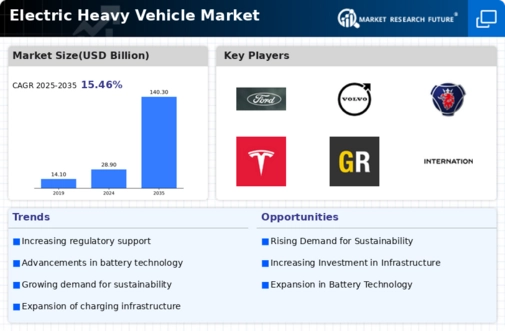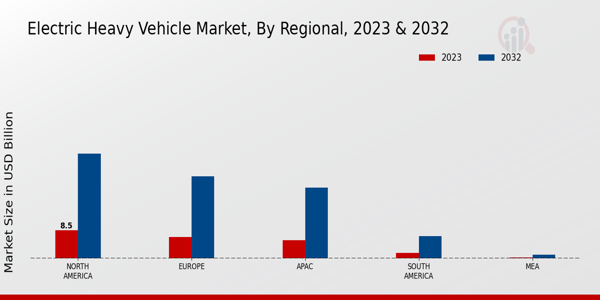Market Growth Projections
The Global Electric Heavy Vehicle Market Industry is poised for substantial growth, with projections indicating a market size of 28.9 USD Billion in 2024 and an anticipated rise to 140.3 USD Billion by 2035. This growth trajectory suggests a compound annual growth rate of 15.46% from 2025 to 2035. Such figures underscore the increasing adoption of electric heavy vehicles across various sectors, driven by technological advancements, regulatory support, and changing consumer preferences. The market's expansion reflects a broader shift towards sustainable transportation solutions, positioning electric heavy vehicles as a key component of future logistics and transportation strategies.
Government Regulations and Incentives
The Global Electric Heavy Vehicle Market Industry is significantly influenced by stringent government regulations aimed at reducing greenhouse gas emissions. Many countries are implementing policies that promote the adoption of electric heavy vehicles through subsidies, tax incentives, and grants. For instance, the European Union has set ambitious targets for reducing emissions, which encourages manufacturers to innovate and invest in electric technologies. This regulatory environment not only fosters growth but also creates a competitive landscape where electric heavy vehicles are becoming increasingly viable. As a result, the market is projected to reach 28.9 USD Billion in 2024, reflecting the impact of these supportive measures.
Rising Fuel Prices and Economic Viability
The Global Electric Heavy Vehicle Market Industry is also propelled by rising fuel prices, which make electric heavy vehicles more economically attractive. As diesel prices fluctuate, fleet operators are increasingly considering the total cost of ownership, which favors electric vehicles due to lower operational costs. Electric heavy vehicles typically have fewer moving parts and lower maintenance requirements, contributing to long-term savings. This economic viability is becoming more pronounced as the market matures, leading to a compound annual growth rate of 15.46% from 2025 to 2035. Consequently, the shift towards electric heavy vehicles is not merely an environmental decision but also a financially sound one.
Increased Demand for Sustainable Logistics
The Global Electric Heavy Vehicle Market Industry is witnessing a surge in demand for sustainable logistics solutions. Companies are increasingly prioritizing sustainability in their supply chains, leading to a greater adoption of electric heavy vehicles. This trend is driven by consumer preferences for environmentally friendly products and corporate commitments to reduce carbon footprints. Major logistics firms are investing in electric fleets to align with these sustainability goals, thereby enhancing their brand image and meeting regulatory requirements. As this demand continues to grow, the market is likely to expand, reflecting a broader shift towards greener transportation solutions.
Urbanization and Infrastructure Development
Urbanization is a critical factor driving the Global Electric Heavy Vehicle Market Industry. As cities expand, the need for efficient and sustainable transportation solutions becomes more pressing. Electric heavy vehicles are particularly suited for urban environments, where emissions regulations are stringent, and noise pollution is a concern. Additionally, infrastructure development, including charging stations and maintenance facilities, is essential for supporting the growth of electric heavy vehicles. Governments and private sectors are collaborating to enhance this infrastructure, facilitating the transition to electric fleets. This synergy between urbanization and infrastructure development is likely to bolster market growth in the coming years.
Technological Advancements in Battery Technology
Advancements in battery technology are a pivotal driver for the Global Electric Heavy Vehicle Market Industry. Innovations such as solid-state batteries and improvements in lithium-ion technology are enhancing energy density and reducing charging times. These developments are crucial for heavy vehicles, which require substantial energy storage to operate efficiently. For example, the introduction of fast-charging infrastructure is enabling electric heavy vehicles to compete more effectively with traditional diesel counterparts. As battery costs decline and performance improves, the market is expected to grow substantially, with projections indicating a rise to 140.3 USD Billion by 2035.
























